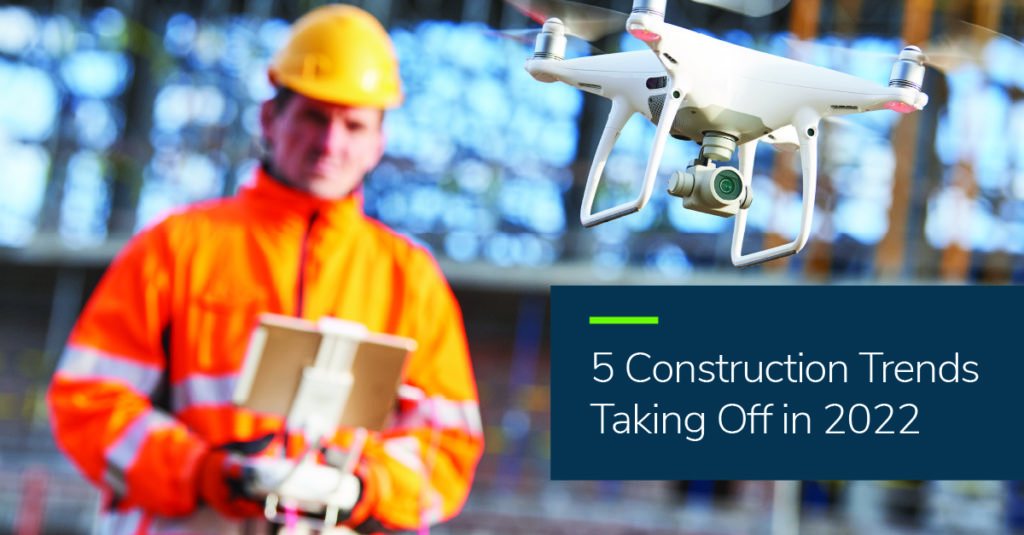
“Next year” is no longer months away. 2022 is here, and NexTec Group is committed to helping construction businesses navigate what appears to be an interesting (for lack of a better word) year ahead. We’ll continue advising them on which cloud construction management software is right for their needs (Hint: Acumatica Cloud ERP and Acumatica construction software), and we’ll also look at 2022 construction trends to help construction businesses anticipate and meet customer demands using modern technology.
Construction Trends in 2022
In a recent post on the new infrastructure bill (Infrastructure Investment and Jobs Act or IIJA) signed by President Biden on November 15, 2021, we discuss the positive impact it will have on the construction industry and question whether labor shortages and supply chain challenges could counteract the positive impact.
In the blog, we state, “According to Construction Dive, IIJA ‘includes $100 million over five years to accelerate the deployment of digital construction technologies such as 3D modeling software and digital project management platforms.’ The bill recognizes that construction companies, for far too long, have managed their business operations with inefficient methods, including paper-based processes and aging technology.”
This leads to our first construction trend.
- Modernization (or Digitization)
The modernization of the construction industry is happening. Construction companies are waking up to the fact that overcoming challenges and meeting new demands (such as supplied by the IIJA) will require them to modernize with cloud software. Digital software solutions for small-to-medium businesses (SMBs) are becoming increasingly available, and the construction management ERP software that a construction company chooses should be both affordable and designed to meet the construction industry’s unique needs.
For example, it should connect every aspect of the business end-to-end and provide financial, project, inventory and customer data in a centralized database, opening up the doors of communication (and collaboration) between employees in the office and those in the field. The increased visibility helps decision makers make wise choices based on updated, accurate facts. And with rising inflation (a not-so-wonderful trend), modern technology can help keep costs down by improving scheduling and workflow efficiency.
- Automation and Smart Technologies
The modernization of the construction industry is not only seen in the adoption of cloud-based construction ERP software but also the adoption of automated and smart technologies. For example, technology companies are creating robots that can replace human labor, taking over repetitive tasks (e.g., painting, digging, welding and more) that take time and effort that may be best spent elsewhere.
A WIRED article discusses the automating of the construction industry using a company that has designed a dry-wall-installing as an example. “About the size of a kitchen stove, the four-wheeled robot navigates an unfinished building carrying laser scanners and a robotic arm fitted to a vertical platform. When placed in a room, the robot scans the unfinished walls using lidar, then gets to work smoothing the surface before applying a near perfect layer of drywall compound; sensors help it steer clear of human workers.”
While it will more than likely be years before this type of robot becomes the norm, drones for monitoring progress and safety are already being used by construction firms across the world. And Big Rentz’s article, How Construction Robots Will Change The Industry, highlights how Articulated, Cartesian and Collaborative robots are changing the face of manufacturing, 3D printing and human/robot collaboration.
- Modular Construction and Pre-Fabrication
The popularity of modular and pre-fabrication construction has been on the rise for years, and it’s not diminishing. Making and assembling building components offsite using the aforementioned automation and smart technologies and having them shipped to and installed at a worksite is an economical and labor-and-time-saving proposition.
Additionally, construction companies that have implemented construction ERP software can manage and track this offsite process, staying abreast of where these building components are, if there are any issues, and if they’re on schedule (or not).
- Using New or Different Materials
With supply chain and rising inflation woes stretching into the foreseeable future, construction companies are finding new generation materials to help them keep their projects moving forward cost-effectively.
For Construction Pros provided a list of these new, innovative materials in 2018, including (but not limited to) self-healing concrete, 3D graphene, laminated lumber, transparent aluminum, light-generating concrete and spider silk. Though they aren’t common materials utilized in today’s construction sites, they are fast becoming popular alternatives as the challenges of 2021 affect 2022.
- Sustainability
Last but definitely not least, construction companies are jumping on board with sustainability. Of course, some of the excitement on their part may be due to increased public interest in environmentally friendly projects. Whatever the impetus, construction companies will be upping their sustainability game by seeking out materials that are ethically sourced, reducing their energy costs, establishing a waste management system and monitoring their carbon emissions.
Cloud Construction Management Software That’s Trend-Worthy
Like every well-designed-and-constructed building, construction companies must have a proper foundation. In this case, the proper technological foundation. They need to research, select and implement cloud-based ERP software designed specifically for the construction industry. The software must also be able to flex with inevitable changes and aid them in staying up with the trends.
NexTec’s complimentary “Construction Management ERP Selection Guide” can help construction companies find what they’re looking for. The guide defines ERP software, discusses its benefits, points out the features an ERP for construction must possess, walks through the construction ERP selection process and discusses one of the best business management software systems for construction – Acumatica Cloud ERP.
Acumatica is the complete Cloud ERP solution for all your business management needs today and in the future. It manages all areas of your business using a modern, flexible and adaptable platform that lets you focus on productivity and growing your business. To learn how a modern ERP solution can help your company keep up with the digital economy, reach out to us. We’d love to show you what Acumatica can do.
